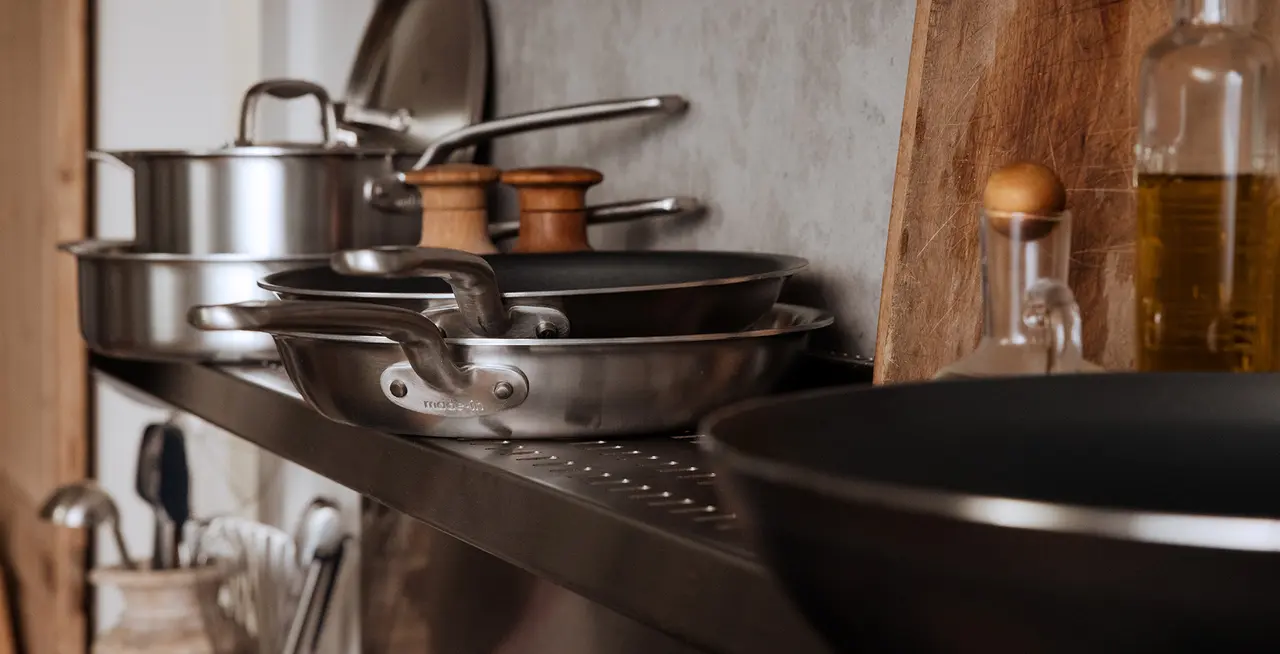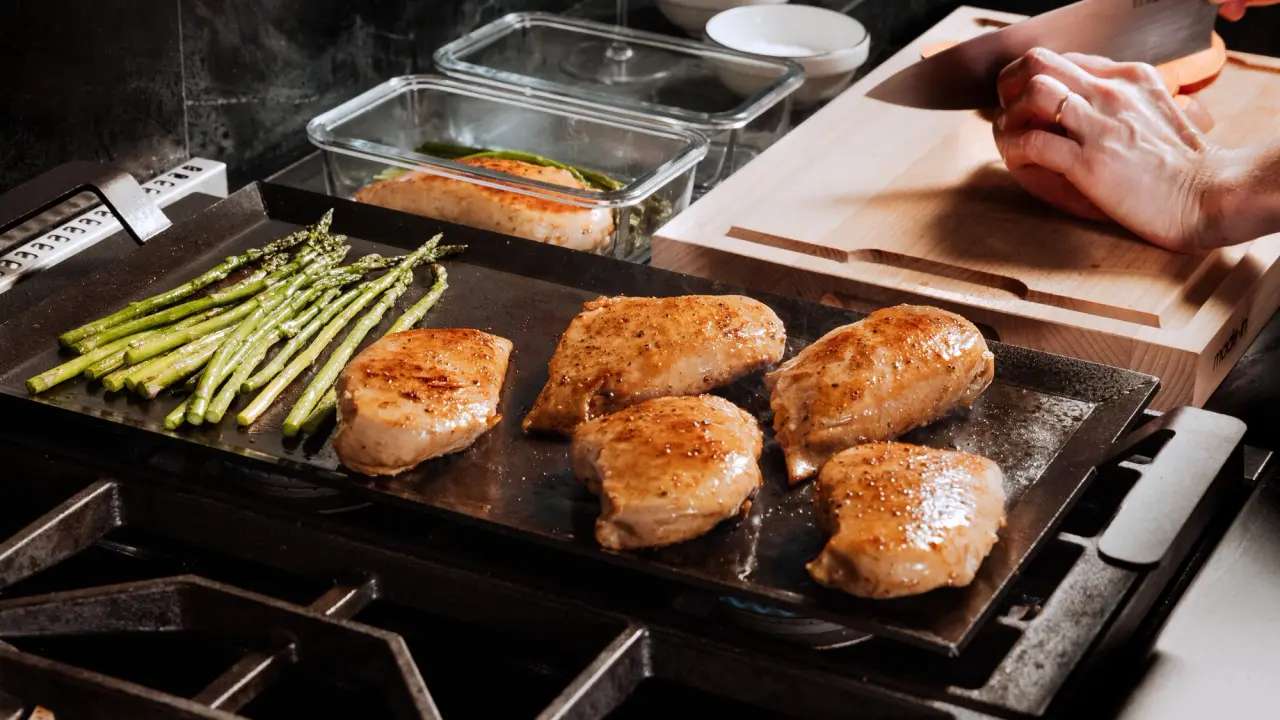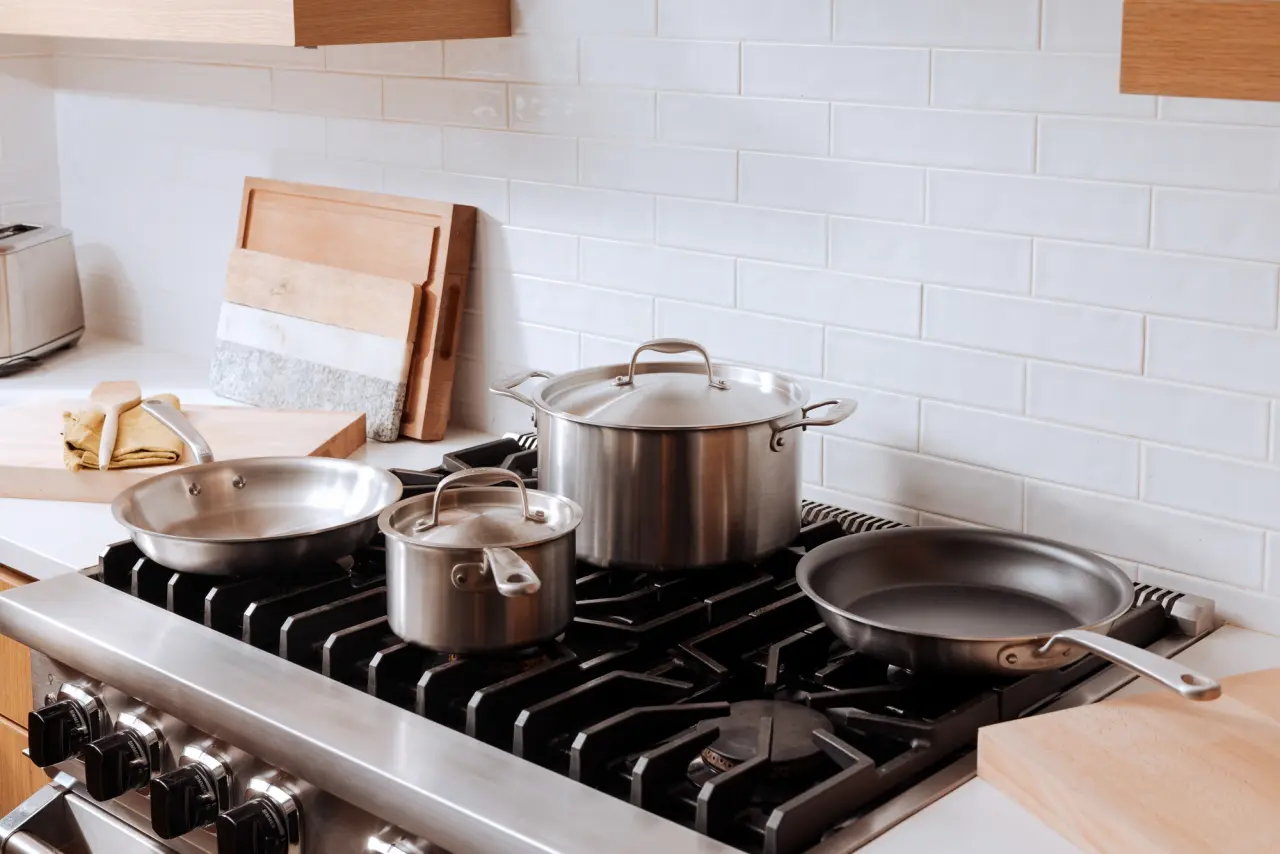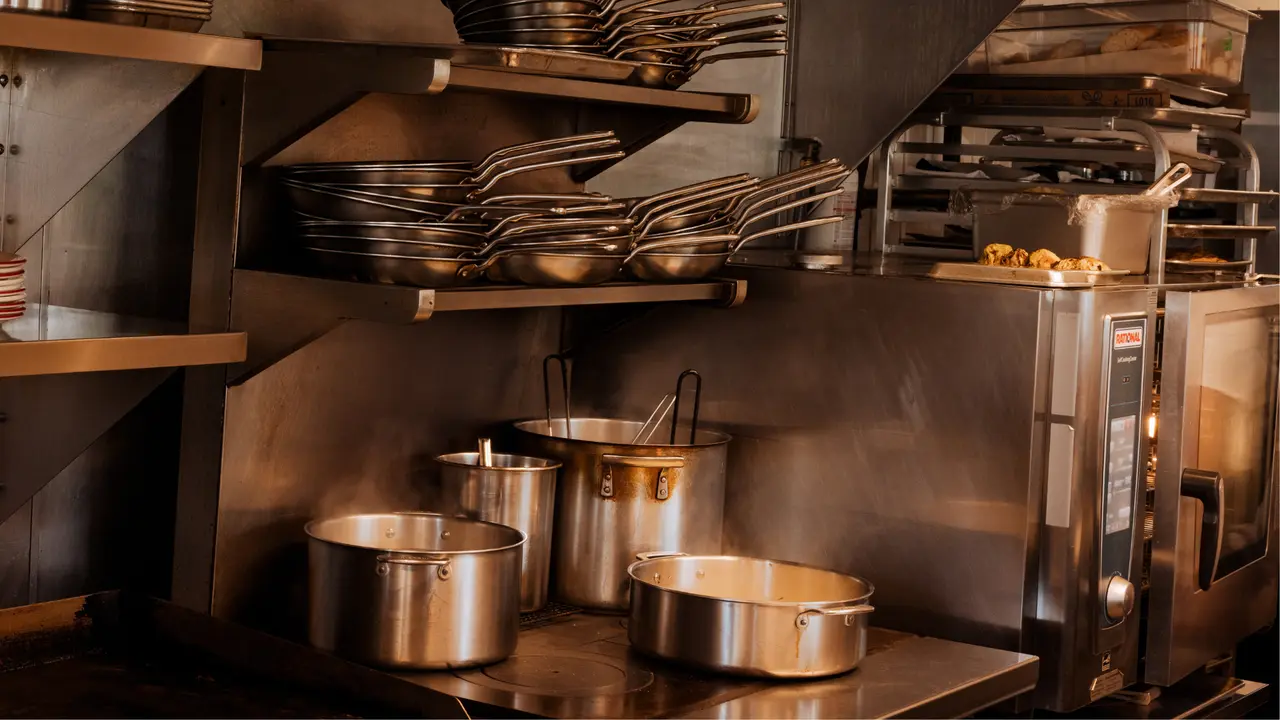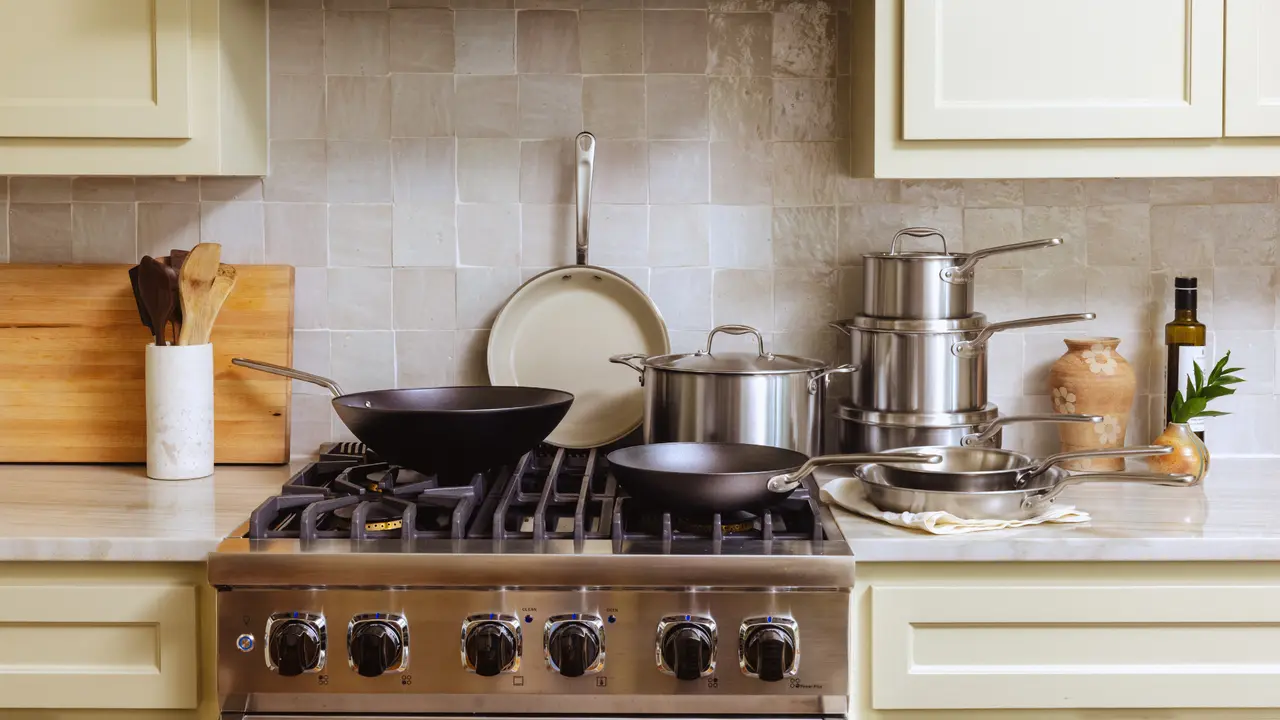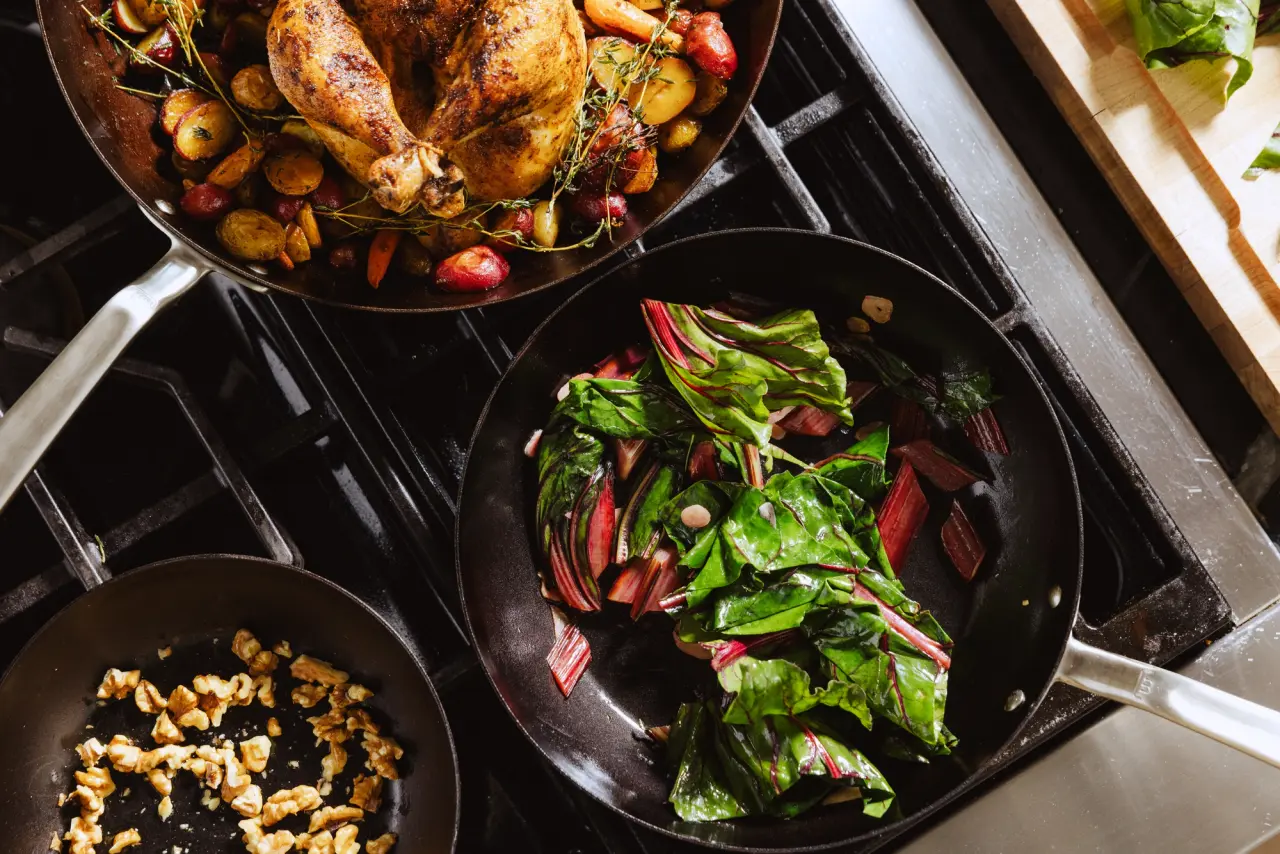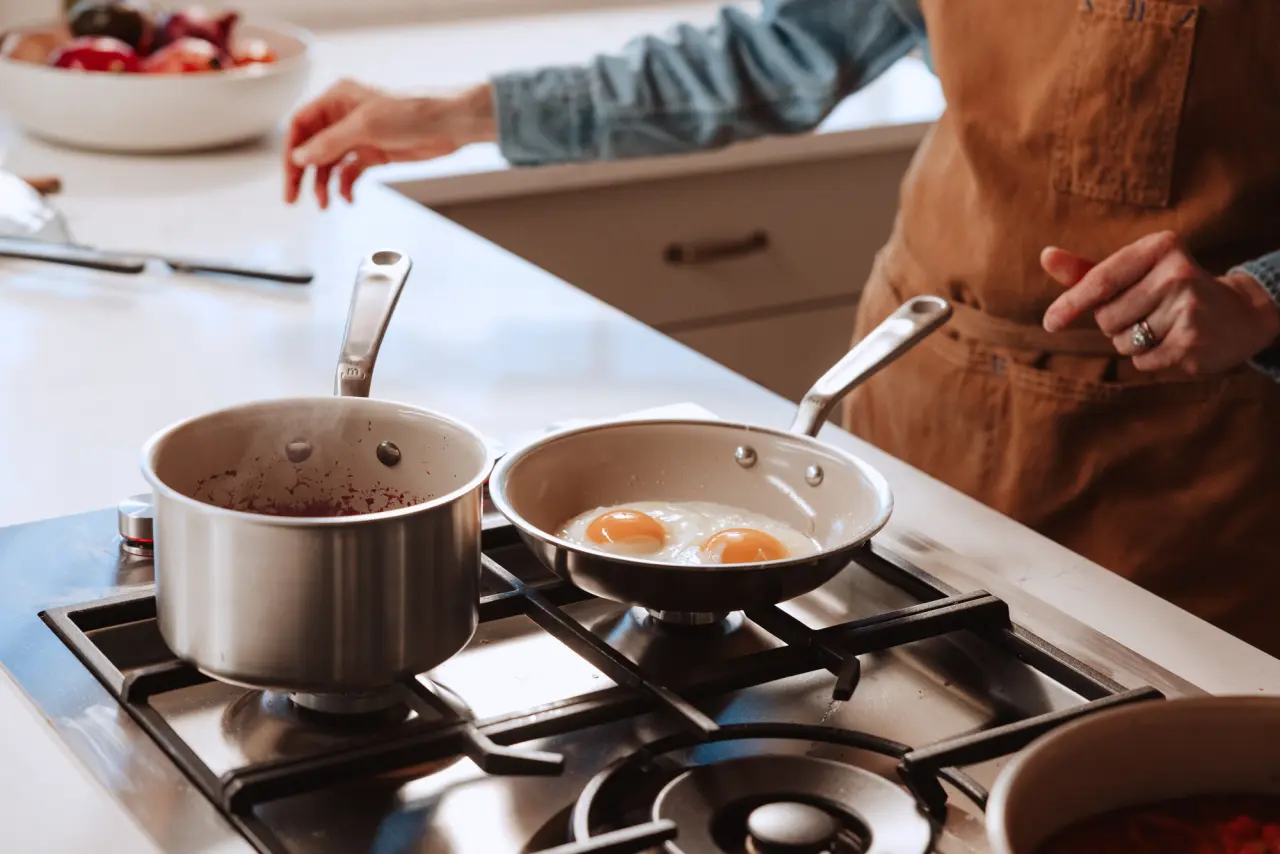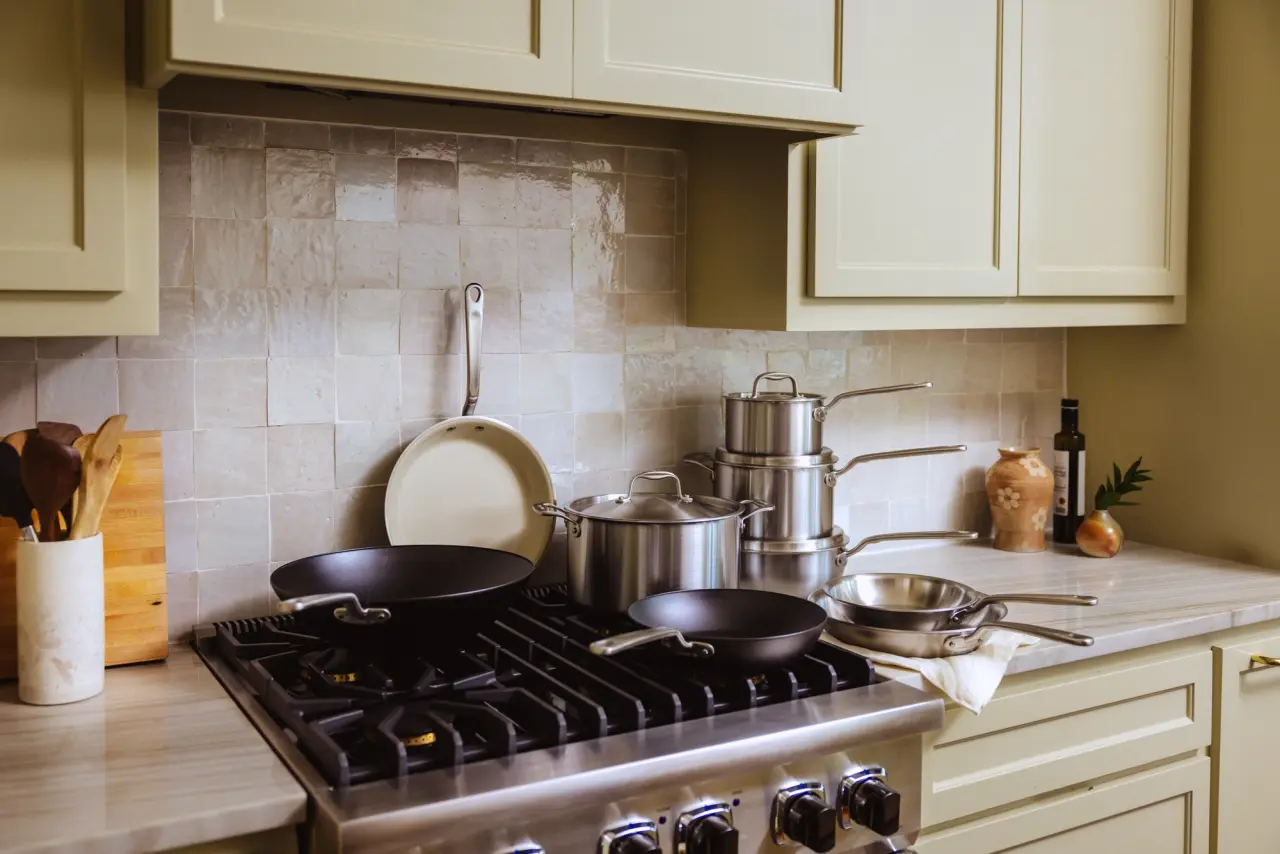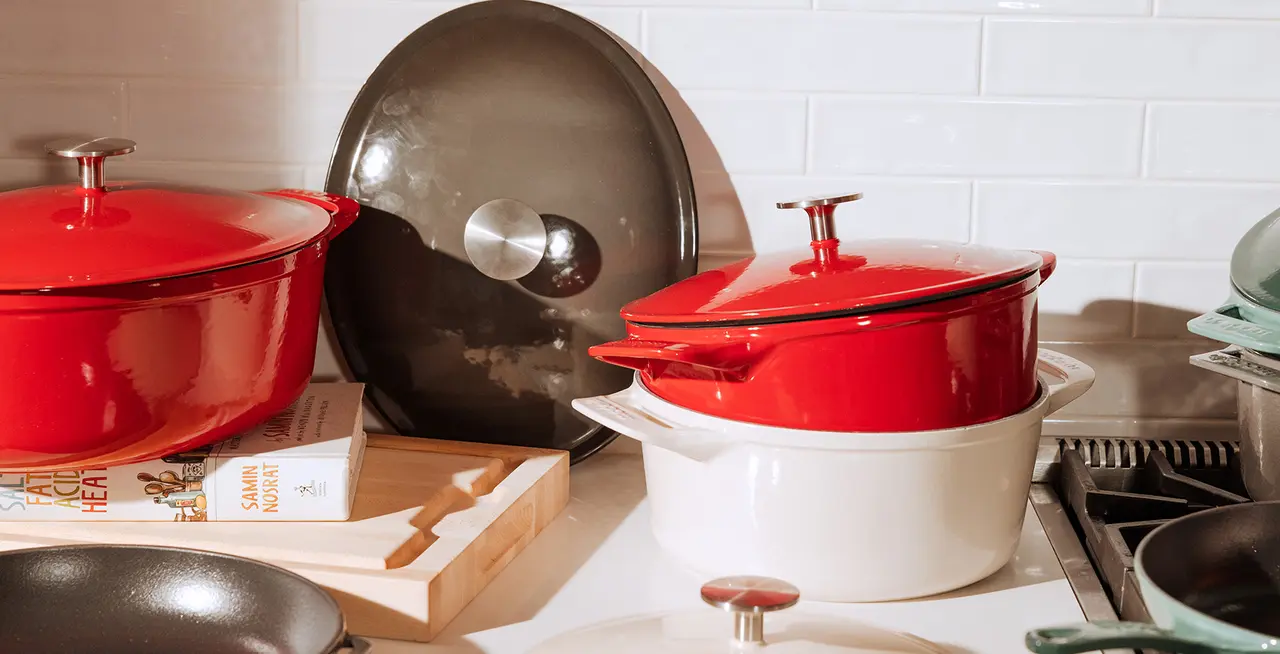From carbon steel to enameled cast iron, we think almost every single type of frying pan has its merits. But if you’re just getting into the home cooking game, or you’re looking to expand your toolkit, the sheer variety of pans on the market can feel intimidating—especially if you’re just looking for a good all-purpose pan for weeknight dinners.
To give you a running start, we’ve put together a guide to six of the most common pan materials, how to cook with them, what they’re best used for, and how to decide which one is right for you.
Carbon Steel
Carbon steel cookware boasts the naturally non stick properties and great heat retention of cast iron, combined with the cooking speed and heat control of stainless steel. We’d recommend reaching for carbon steel when searing steaks or anything else cooked over high heat—though it’s versatile enough to use for low-heat cooking as well.
Similarly to cast iron, carbon steel pans need to be seasoned before use (though some, like ours, do come preseasoned). As if these pans weren’t already versatile enough, carbon steel is also safe to use on the grill as well as over an open flame.
Carbon Steel Advantages:
Carbon steel pans are just as suitable for high heat cooking as cast iron, but with a lighter, less bulky profile. Here are some distinct advantages of using this pan.
- Carbon steel pans offer the same high heat retention as cast iron options, but with around half the weight.
- The more you cook with carbon steel, the more non stick it gets—especially if you cook with fatty proteins like steaks, bacon, or burgers.
- They can handle extremely high heat—all of our carbon steel cookware is heat-resistant up to 1200F, meaning these pans are safe to use in the oven.
- They’re compatible with every type of cooktop—including induction.
Carbon Steel Considerations:
While the drawbacks of using carbon steel cookware are few and far between, they do come with a slightly more involved user manual than non stick or stainless steel pans.
- Like cast iron, carbon steel cookware needs to be seasoned before using to make it non stick, and that seasoning will need to be maintained over time.
- Use of acidic ingredients (citrus, vinegar, wine, even tomatoes) will strip the seasoning. This is easily remedied with a quick reseasoning—just a few minutes of active work required.
- Also like cast iron, carbon steel is more prone to rust than other types of cookware, especially if it hasn’t been seasoned properly or used in a while—luckily, it’s easy to remove.
Ceramic Frying Pans
Ceramic frying pans are often marketed as an alternative to traditional coated non stick pans. While they boast a glossy, ceramic-like coating, the name is actually a slight misnomer: typically, ceramic pans aren’t made of ceramic at all. Instead, they’re made from a metallic (typically aluminum or stainless steel) core coated with several layers of a material derived from silicone.
Ceramic pans are functionally similar to traditional, coated non stick pans, but are made without the use of chemicals and have proved to be a welcome, totally non-toxic addition to many cookware collections.
Ceramic Advantages:
Ceramic cookware fares well when it comes to convenience, looks, and the ability to purchase in a set.
- Like non stick pans, ceramic pans are a breeze to cook with and clean because of their non stick surface.
- Ceramic cookware is produced completely without chemicals, which is helpful for households who want to remove possible toxins from their cookware.
- Ceramic pans are generally compatible with all types of ranges, including induction.
Ceramic Considerations:
The main drawbacks of ceramic cookware include relatively poor heat distribution and less longevity than many non stick pans.
- Ceramic cookware made with an aluminum-based core is much more prone to warping, so shoppers should seek out higher-quality options with a hard-anodized aluminum or stainless steel construction.
- Ceramic pans are often not completely oven-safe due to the construction materials of the handle, which can reduce the uses (and usability) of the pan. Look for pans made completely of stainless or aluminum, without plastic or faux wood handles, to guarantee oven usability.
- The coating will naturally degrade over time, so it will eventually lose its non stick capability.
Copper Frying Pans
Copper cookware is best known for its luxurious finish and excellent heat conductivity, as well as for its price—a small copper saucepan can fetch around $200, while a stockpot can cost upwards of $1,000. This makes copper relatively uncommon as a cookware material, though many professional chefs swear by it.
Aside from their looks, one of the distinct characteristics of copper pans is the fact that they cool rapidly once removed from the heat. Copper is strong and notoriously conductive, so it makes for long-lasting, high-performance, and incredibly responsive cookware—perfect for jam, caramel, and other delicate sauces, as well as searing and sautéing, as well.
Modern copper pans—including ours—tend to be lined with stainless steel, which makes for a more durable pan than the more traditional (but much higher-maintenance) tin-lined copper pans.
Copper Advantages:
Copper’s ability to heat up and cool down rapidly is just one the reasons it makes for a great addition to your cookware collection
- Copper pans offers unmatched heat responsiveness and distribution, perfect for often-temperamental recipes like jam, caramel, and chocolate.
- Since tin-lined copper needs to be replaced throughout the lifetime of the pan, many copper pans will often come with a lifetime warranty if you purchase it new. Stainless-lined copper—like ours—does not need to be relined, but will often still come with a lifetime warranty.
- Cooking skill aside, they are aesthetically beautiful and make for a beautiful statement piece to display in your kitchen.
Copper Considerations:
The expense—and lack of induction compatibility—can be a deal breaker for some cooks when it comes to copper pans.
- Copper pans are significantly more expensive than many other types of cookware. While they make a worthy investment piece, some may find the price tag prohibitively high.
- Since copper is not a ferromagnetic material, copper frying pans are not compatible with induction cooktops.
- If lined with tin, copper pans may require periodic retinning (note that our copper cookware is lined with stainless steel and does not require retinning).
Enameled Cast Iron Frying Pans
Enameled cast iron frying pans boast the same durable construction and heat retention as rustic unfinished cast iron skillets, but feature a smooth, elegant enamel coating for easier cleanup. These pans are made the exact same way as our enameled cast iron Dutch Oven: a molten iron-carbon alloy is poured into our proprietary frying pan mold and left to cool, before being coated with an enamel made from powdered glass.
Aside from being available in a range of different colors, the main advantage of enameled cast iron over unfinished cast iron is that it’s much less likely to rust, and is also relatively easy to clean and maintain. And while these pans are more of an investment than mass-market unfinished cast iron cookware, they offer invaluable convenience and elegance that’ll last for several lifetimes.
Enameled Cast Iron Advantages:
Enameled cast iron pans offer all the benefits of unfinished cast iron, with the touch of added convenience usually associated with non stick.
- Enameled cast iron pans offer excellent heat retention, perfect for high-heat cooking methods like shallow- or deep-frying and sautéing.
- Like their unfinished predecessor, they’re durable enough to last for generations.
- The enamel coating on these pans offers a smooth non stick surface, and doesn’t need to be reseasoned like unfinished cast iron.
- Unlike unfinished cast iron, acidic ingredients are no problem with these pans, as the enameled coating is nonreactive and protects the raw cast iron underneath.
Enameled Cast Iron Considerations:
The heft and price tag of enameled cast iron pans can be a potential deal breaker for some.
- While unfinished cast iron pans can be extremely affordable, enameled cast iron pans are pricier, often more than $100—we think this is a worthy tradeoff in terms of time saved with care and seasoning, but those used to the prices of raw cast iron skillets may experience some sticker shock.
- These pans can easily weigh twice as much as a stainless steel or non stick pan of comparable size.
Non Stick Frying Pans
While many pans, like cast iron and ceramic, offer non stick properties, non stick cookware generally refers to modern pans (typically aluminum and/or stainless steel construction) coated with layers of a durable non stick coating.
This non stick coating, which differs from manufacturer to manufacturer, makes these pans an ideal pick for cooking delicate, stick-prone proteins like eggs and fish, as well as for reheating leftovers.
While they typically don’t last as long as other types of cookware, a high-quality non stick frying pan (like ours) can last for a few years with proper maintenance. Our Non Stick Cookware is even oven-safe, so you can use it to sear steaks and chops on the stove before finishing them in the oven.
Non Stick Advantages:
Lightweight and easy to clean, non stick frying pans are all about convenience.
- Because they’re often made with an aluminum or stainless steel core, non stick pans are typically relatively lightweight and easy to maneuver.
- The non stick coating makes cooking and cleanup a cinch.
- Since it’s less prone to sticking, you can use less oil to cook your food.
Non Stick Considerations:
Non stick pans have a relatively short lifespan, and require a bit of vigilance to protect the often delicate coating from damage.
- Non stick quality differs greatly, and ultimately depends on the core construction just as much as the non stick coating—stick to brands that use high-quality materials, sound craftsmanship, and zero shortcuts.
- Delicate non stick coatings can scratch and chip easily, so non stick pans should only be used with specific utensils, like non-abrasive wooden, nylon, and silicone tools.
- Even high-quality non stick pans have a limited lifespan, so you’ll probably need to replace your pan after a few years.
Stainless Steel Frying Pans
Stainless steel pans are a classic in both home and restaurant kitchens—not just because they look professional. Quick to heat up, incredibly responsive to temperature change, and lightweight enough for easy flipping and tossing, high-quality stainless steel does an excellent job cooking everything from delicate vegetables to thick, bone-in steaks and chops.
Stainless steel is an alloy of multiple metals like iron, nickel, and chromium, all of which contribute different characteristics to create a stronger, higher-performance material. You can also find pans labeled “stainless clad,” which are made from several layers—or ply—of different metals and alloys bonded together for optimized heat conduction and distribution.
Our Italian-made 5-Ply Stainless Clad Collection features five layers of four different metals, resulting in an incredibly durable, corrosion- and rust-resistant pan.
Stainless Steel Advantages:
Lightweight, easy to maneuver, and with unrivaled heat control, the advantages of stainless steel pans make these an absolute staple in any kitchen.
- Stainless steel offers unrivaled heat distribution—particularly if your pan is fully cladded.
- Stainless steel is non reactive, meaning it’s safe to use with acidic ingredients. Reactive cookware includes aluminum, tin-lined and pure copper, unfinished cast iron, and carbon steel.
- Stainless steel pans can handle very high temperatures—our Stainless Clad is oven-safe up to 800F.
- Stainless steel’s relatively light weight makes for easy lifting, flipping, and tossing.
- Excellent heat control makes stainless steel versatile enough for both high- and low-heat cooking methods.
Stainless Steel Considerations:
While stainless steel pans are incredibly versatile, you’ll need to take a little extra care to keep them from rusting or sticking.
- Stainless steel pans are more prone to sticking than well-seasoned carbon steel, enameled cast iron, or non stick pans. This is easily avoided by studying up on how to cook with stainless steel to learn proper preheating etiquette.
- These pans tend to lean on the pricier side, particularly if you’re buying high-quality stainless—but we firmly believe the cost-per-use more than justifies a higher upfront price.
How to Choose the Best Frying Pan for You
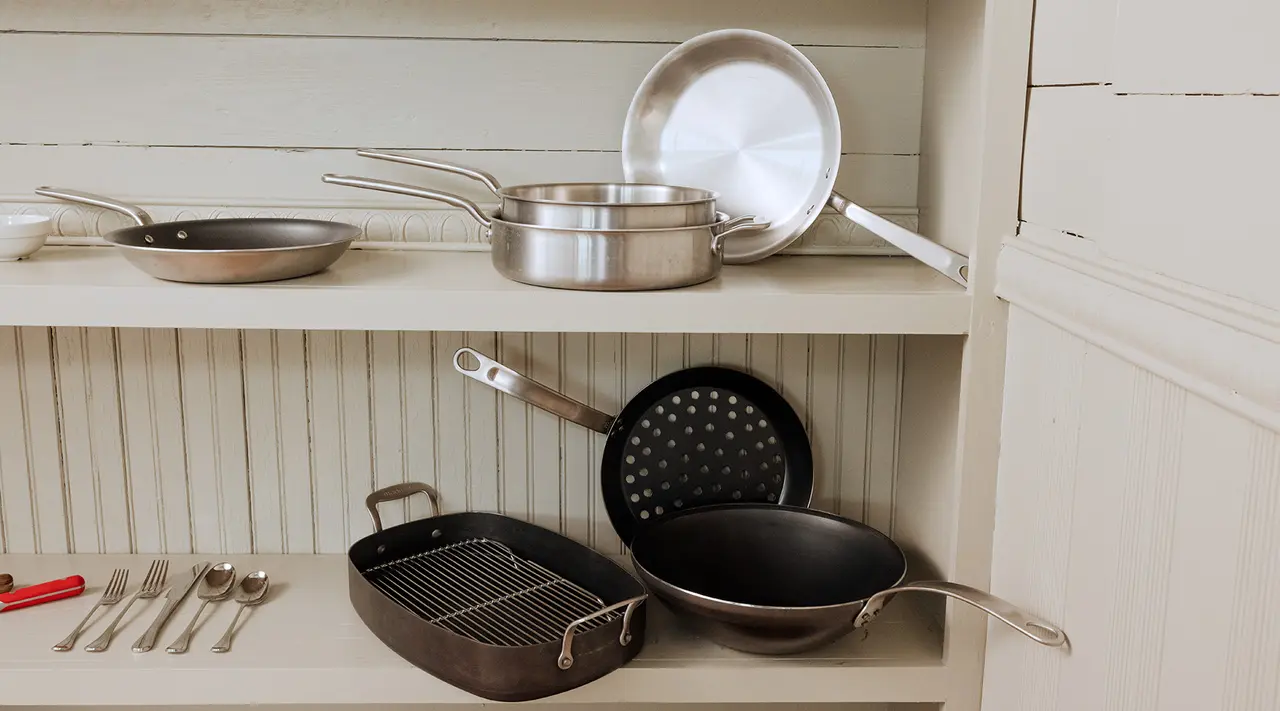
Choosing a pan definitely doesn’t need to be stressful—and it shouldn’t be. But choosing a great pan definitely takes a bit of research and forethought.
First off: what recipes do you actually plan to use it for? If you’re a single cook whose typical weeknight meals consist of single-serving dishes or reheated takeout, a non stick pan is a great affordable, low-fuss option. If seared duck confit, skillet cornbread, and Spanish tortillas sound more like your speed, it may be worth investing in a stainless steel, enameled cast iron, or carbon steel pan in any size.
Another factor to keep in mind when shopping for a pan is the amount of space you have available. If you have a large kitchen with ample drawer space and a pot rack, for example, you can justify picking up one (or more) of each. For more compact kitchens, however, a smaller multi-material set will allow you to do a lot with a little—especially if you know how to store your pans.
Ready to Shop?
Worried about choosing the “best” frying pan? Well, don’t—it doesn’t exist. Instead, think about which pan is going to enhance your daily cooking experience. And while you don’t need to spend a ton on a good frying pan, we definitely recommend investing in a high-quality one you'll be able to reach for night after night, regardless of what you're cooking. Not only will a high-quality pan perform better, but it’ll also last longer.
